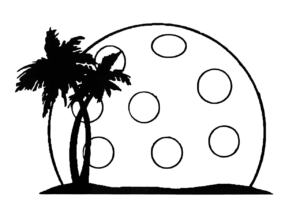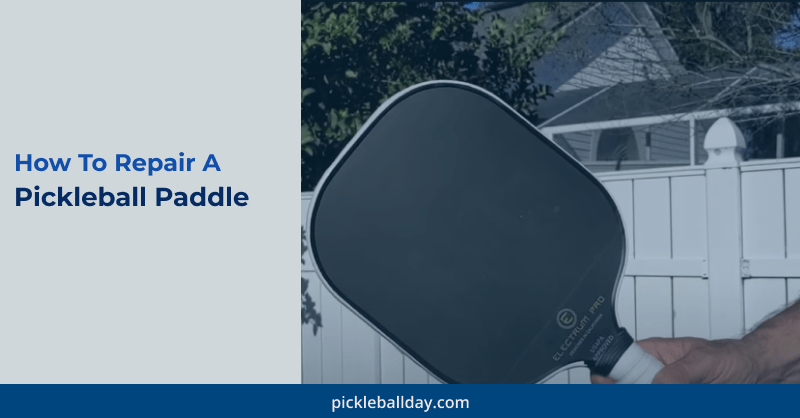Although the expected lifespan of a paddle is limited to one to five years, you can extend its period the most based on the materials it is made of. And by avoiding it getting damaged or hurt, you will be able to get the best output every time.
You cannot expect a pickleball paddle to last forever; it usually lasts for 4 to 5 years, depending on your playing style and playing frequency. Besides, how you take care of your paddles is vital to keeping them effective all the time and making them safe from damage.
In this article, I will discuss how a pickleball paddle gets damaged, how you can make it safe, and how you can repair a damaged one.
Table of Contents
How The Pickleball Paddles Get Damaged: Understand The Reasons
You should understand the common reasons that damage your paddle. Once you know about the casualties, you can avoid them, keep your paddle safe, and use it for a long time.
Reasons for Pickleball Paddle Damages
Several reasons cause damage to a pickleball paddle. Some are environmental causes, while some grow from abuse and lack of care. However, the following are some of the most common reasons:
- Not using the paddle cover
- Not cleaning the paddle
- Lifting objects from the ground
- Playing in Extreme Weather
- Hitting Other Paddles
- Throwing Paddles
- Slipping during the game
Not Using the Paddle Cover Properly
Use a paddle cover. Keep the paddle inside its cover when it is not in use. It’s common for pickleball players to not use the cover properly. They tend to leave the paddle on the backseat or floormat of the car all the time when they return from the court or are not playing. Besides, they roughly keep their paddles on the desk or with other equipment in the garage. This is some kind of negligence.
Your paddle is designed to hit the ball only, and it’s already taking a lot of strikes and scratches on the hitting area during the game. So when any other sharp objects scour the paddle, like the edge guard or surface materials, they only hurt it.
Not Cleaning the Paddle
The paddles contain dust on all external parts, surface materials, grips, and edge guards. After each game, you must clean up these pollutants with care. Though it takes only a few minutes, lazy people like me care little about cleansing the paddle, which over time causes harm like unnecessary scratches, loosening the grip, etc., because of the thick accumulation of sand and dust.
Lifting Objects From the Ground
A pickleball paddle is designed to hit the ball only. Therefore, its core and surface materials are designed to do the strikes properly. So, you are just misusing your paddle when you lift or move any other objects like shoes or goggles on the court. It’s not that the paddle will break if it is used for other jobs, but still, the texture of the surface materials will be impacted. A smooth textured surface is responsible for the smoother spin of the pickleball. Besides, the edge guard gets scratched by sharp objects, destroying its thickness and causing fractures.
Playing in Extreme Weather
The weather has a direct impact on the materials used in the pickleball paddles. For example, extreme heat will make the core materials softer and cause the glue to lose its adhesion that binds the core, surface, and graphics. Besides, it’s responsible for exfoliating the surface.
Moreover, snow and cold are not good for paddles, especially for their core materials. The harsh cold will make the core and surface rigid and brittle. In extreme cases, the paddles might break in the middle of the game.
Even if it’s a unibody paddle, you should avoid keeping the paddle in the hot sun for a long time.
Hitting Other Paddles
Clashes between players might happen when you are playing doubles. Any hard hit from other players or paddles might result in a great loss to your paddles, leaving deep scratches. Or sometimes, you might just end up with a broken paddle.
Besides, as a sign of sportsmanship, players touch their partner’s and opponent’s paddles. It’s not a big deal, but with the continuous clinking before and after matches, the scratches become permanent on the paddle, particularly on the edge guard. So next time, it cracks when the ball hits the scratched area, which has already become weak and thin.
Throwing Paddles
Throwing the paddles will make them useless. Whether it breaks or not, the shape might be permanently changed. The paddle is not the object you should use to eliminate your anger or excitement.
Slipping During the Game
Slipping the paddle out of your palm happens for two reasons. First, it happens because of not tying the paddle with your wrist. Second, the paddles might slip due to a slippy grip. After days of use, the grip becomes loose. The soft, padding-type materials are designed to absorb sweat as well. Therefore, over time, the dust and sweat cause it to lose its tightness and strength, which ends up losing its traction.
Clean the paddle grip with a damp cloth after each game, and replace the old one. Do not hesitate to get a new grip; it’s cheap, and the regripping is easy to follow.
As you know the responsible grounds, you can now avoid them happening to your paddles. Play the game for fun have health benefits and control your emotions.
How to Fix a Pickleball Paddle Edge Guard
The edge guard of your paddle is the one significant part, but it goes through numerous abrasions. As a result, its health quality decreases and it might get loose or suddenly fall off over time. In that case, you can fix it by simply gluing. Or, you can buy a new one. Whatever the plans, apply them without wasting time when the edge guard starts to fail or damage.
Some paddles are unibody, meaning they might not need an edge guard as an essential part, but an edge cover still adds good looks and value to your paddle. The edge guard keeps all the things combined off your paddle for other standard paddles, which are made of several materials. Therefore, if it is loose or falls off, all other materials prone to the risk of scratches, including the core, surface material, and graphic cover, start to separate. After a certain level, you might not be able to recover your paddle, ending a costly purchase only because of a simple edge guard fix.
So, how to fix a damaged edge guard? The way is simple and precise. Follow the next steps:
What you will need
- Rubbing alcohol
- Piece of soft fabric or cotton ball
- Adhesive remover
- Glue
- Hair dryer or hot blower
Remove the Remaining Glue
Applying new glue is the easiest and most common repair to your edge guard needs. It holds itself together with paddles with an adhesive bond. Because of the weather, you must reglue the edges when the glue loses adhesion. You can regain the broken old edge cover by regluing too.
However, you first need to clean the old glue out for regluing. Any old junk, including dust and adhesives, will block new glue from setting, and you can remove them easily using rubbing alcohol.
- Soak a clean, soft cloth or a cotton ball in the alcohol.
- Then rub the area where the glue needs to be applied.
- Don’t be in a hurry; it’s a slow process.
- Some remnants might refuse to be removed with alcohol. You can use a regular adhesive remover like Goo Gone.
Apply New Glue
After cleaning the applicable edges, wait a few minutes until it dries, and apply a good glue that can tolerate outdoor weather. You can use Gorilla glue, which is compatible with paddle materials, suitable for restoration, and produces a long-lasting bond. Besides, once it dries, you can easily rub off the unwanted glue with a damp cloth.
Apply the glue for a smooth coat, and press the edge guard areas into their actual position to seal them up. For cracks, drop glue inside the fractures. You should not apply excessive glue because it will only be a waste of time and demand extra hours to dry.
Let the Glue Dry
You do not need to hold the edge covers for long if it’s an instant glue. However, hold the paddle and covers together while it dries. Then, allow the glue to cure completely. You can use a hot blow dryer or hair dryer to expedite the drying time. However, do not use a high temperature; it might create glue bubbles.
Based on the different brands and materials, glues might take 6 to 72 hours for a complete cure. Read the instructions on the package and follow them for the required time.
Prevent Potential Damages
You cannot get the actual performance from your paddle by continuously regluing the edges in the same spots or cracks. Therefore, take care of your paddle and use it with attention to avoid scratches and damage to the edge guard. In extreme cases, replace the old one, and there are affordable edge covers.
Tips to Keep Edge Guards Long-Lasting
- Every time the edge guard gets a scratch, it loses its lifetime. Avoid the reasons that cause scratching.
- Do not use your paddle to move anything on the ground.
- Do not use your paddle to lift the pickleball from the floor.
- Whenever you find the edge guard starting to loosen, fix it with an adhesive.
The main pieces in a pickleball paddle are its core and surface materials, both of which are well protected by the edge guard. Do not bother replacing it with a good one if it gets badly damaged. Replacing the edge guard is easy and affordable.


